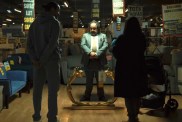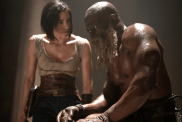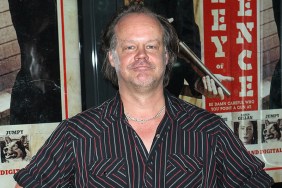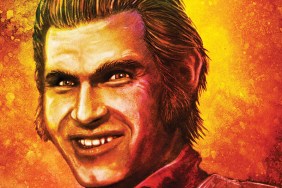Legendary German/American actor Udo Kier discusses his new film Courier-X and touches on his long, diverse career
German born actor Udo Kier has been beloved for decades and is know primarily for his endless roles in European cult and horror films. From Mark of the Devil to Paul Morrissey’s Flesh for Frankenstein and Blood for Dracula (more on those below) to House on Straw Hill and beyond. In fact, you can have look at our favorite Kier performances in this feature here.
But Kier is no one trick pony. He veers effortlessly between indie fare, provocative arthouse pictures, lowbrow genre efforts and mainstream Hollywood movies. And every time, no matter how big or small the role, it’s almost a given that Udo will walk away with the movie.
Currently available on all digital platforms is one of the latest Kier vehicles, director Thomas Gulamerian’s Courier-X, a paranoid thriller that sneaks behind the scenes and examines the conspiracy theory that the White House Administration intentionally shot down the very real, very tragic Flight TWA 800. Kier plays a former member of the East German Police-The Stasi- in a multi-layered story covering the events of Flight TWA 800, a blackmail attempt on the CIA after Pulitzer Prize winning journalist, Gary Webb, released his on-line article, ‘Dark Alliance,’ and a clever cat-and-mouse game between a Manhattan crime boss and a smuggler of black market merchandise.
We spoke to the awesome Udo Kier about the film and touched on many aspects of his career. Enjoy!
ComingSoon.net: I love your genre work but it’s always nice to see a contemporary filmmaker use you in a serious role, like here in Courier-X.
Udo Kier: Yes, but in fact I just made several films, one with Alexander Payne and Matt Damon in Los Angeles and I just came back from New York making a movie with Vince Vaughan. None of these films are horror. It’s logical when you become known to the industry with Dracula and Frankenstein that they typecast you and want you in their horror movies. That’s how I got Blade, of course, because they were fans. But even when I was in Germany, I made nothing but serious movies with people life Fassbinder and Wim Wenders, nothing related to horror.
CS: Okay, so here you are flying around the country to star in some pretty high profile films and yet you still take on a modestly budgeted indie film like this with a first time director. What was the appeal?
Kier: Well, it was the story first. I liked the story. And the script. And the character, this ex-German Stasi who was working as an informant for the CIA. That was an interesting role. It was complex and then set against that big story of the idea of a conspiracy of the plane crash. And you know, sometimes I get scripts and there’s just nothing special and I see that anyone can play that role. But with young filmmakers, they want me. They create good roles for me because they need me. They need me for my name and they can attach me to the film and its easier to get other actors. So it’s always interesting to work with young filmmakers.
CS: Do you still audition?
Kier: Depends for who. If David Lynch wants me to audition I will do it. But a young filmmaker, no. I won’t. I haven’t auditioned for a very, very long time. I do meetings. When John Carpenter wanted me for (Masters of Horror episode) Cigarette Burns, he invited me to lunch at Musso and Frank and then after coffee he said, okay, let’s do the film together. I think it’s important for a filmmaker to know his actors, because you have to work so closely together and you have to like them or you’ll have a horrible time.
CS: You’ve worked with Lars von Trier for decades and it’s always a joy to see you appear in his movies. Does he write roles for you?
Kier: No. We met at a festival in Germany and I saw his first film, The Element of Crime, and I had a short film there in competition and out of all the movies I saw, that was the only one where I demanded to meet the director. I was blown away. So I met him and I was expecting a kind of intense looking director, dressed in black and he was almost like a young student. A few weeks later he offered me a role in his film Medea. He said “you don’t look like a Viking so don’t shave and let your hair grow out”. So I did and I was given the role of the king of the Vikings. We became friends and since then I was in almost every film except two. And I also became the Godfather of his first child! So what happens is he gives me a script to read and give my thoughts and I get to choose a role. For example, in Nymphomaniac, I said “what about this role?” and I get it. In Melancholia everyone talks about my part. If you have a smaller role, but if you work with a great director, they make it unforgettable.

CS: In respect to both Nymphomaniac and Melancholia, no one does disgust better than you.
Kier: (laughs) thank you. The thing is, I could have played a bigger role in Nymphomaniac, the guy who doesn’t want to have sex on the train. But I thought the funny role was the waiter who figures out where the woman put the spoon. And I like that. I like to take roles where the audience knows more than I do.
CS: In Courier-X, because you have worked all over the world and with all the greats, did you find it hard to take direction from someone who had not directed before?
Kier: No, I discussed the role. I suggest things if I think I can do it a better way and that’s what we did. The role was not written for me. If it was, it might be wrong because the writer might have seen me wrong. But Thomas and I had long conversations. The same way Alexander Payne and I did. We had lunch and discussed the role. I’m not a puppet. It’s collaborative.
CS: You started directing a film some years ago. What happened to that?
Kier: Yes…Broken Cookies. I was the writer, director, the actor…I had to do everything and after 10 days my money was flying out of the window. So I stopped the movie. I might finish it one day. I might direct something else. I bought a lot of property and I want to make a western one day, about people who want to become cowboys for a week. Lawyers, doctors…
CS: Like Westworld.
Kier: Yes, but without the science fiction.
CS: You’ve made over 100 films.
Kier: Oh, no…the internet tells me it’s over 220. But I don’t count them.
CS: A lot of people I know who have been in the business this long, cannot suspend disbelief anymore. They can’t watch and enjoy narrative films anymore. Can you?
Kier: Well, I don’t go to the cinema as much anymore. But I follow the work of certain directors, like Almodovar and Gus Van Sant, who really discovered me for America for his film My Own Private Idaho. He’s the own who got me the work permit and I just stayed in LA, have been here 25 years.

CS: I have to ask the question that I’m sure everyone asks you, for my own curiosity.
Kier: Okay, go ahead.
CS: Italian prints of your signature films Flesh for Frankenstein and Blood for Dracula are not credited to director Paul Morrissey, but rather Italian filmmaker Antonio Margheriti. Who really made these movies?
Kier: Paul Morrissey of course. I will tell you the quick story. I was sitting in an airplane and I was sitting next to a young man with a beard and we started talking and he said, “Hey, what are you doing”, and I said “I am an actor”. This was the beginning of my career. So I showed him a picture of myself. And he said “wow, that’s interesting. Give me your number”. So he wrote my number on the last page of his American passport. And I said to him and I said, “who are you, what are you doing”. And he said “I am Paul Morrissey, I direct for Andy Warhol” and shortly after that, three months later, I got a call. “Hey, it’s Paul from New York! I’m making Frankenstein for Carlo Ponti and I have a little role for you!” I asked what the role was. He said “Frankenstein”. So, Flesh for Frankenstein was made in 3D. And why Margheriti is credited on some prints is that there were too many Europeans in the film and by law you had to have a European director on set. I met Antonio before because of his movies in Spain and Italy. Fellini was shooting next door to us. On the last day of shooting, Morrissey came to me and said, “well I guess we have a German Dracula”. I said “who?” He said “you!”. I had to lose a lot of weight in three weeks so I starved myself and only ate leaves and drank water. At the beginning of Dracula, I sat in a wheelchair because I didn’t have any power. Not only Robert De Niro physically prepares himself for movies, I do as well!









